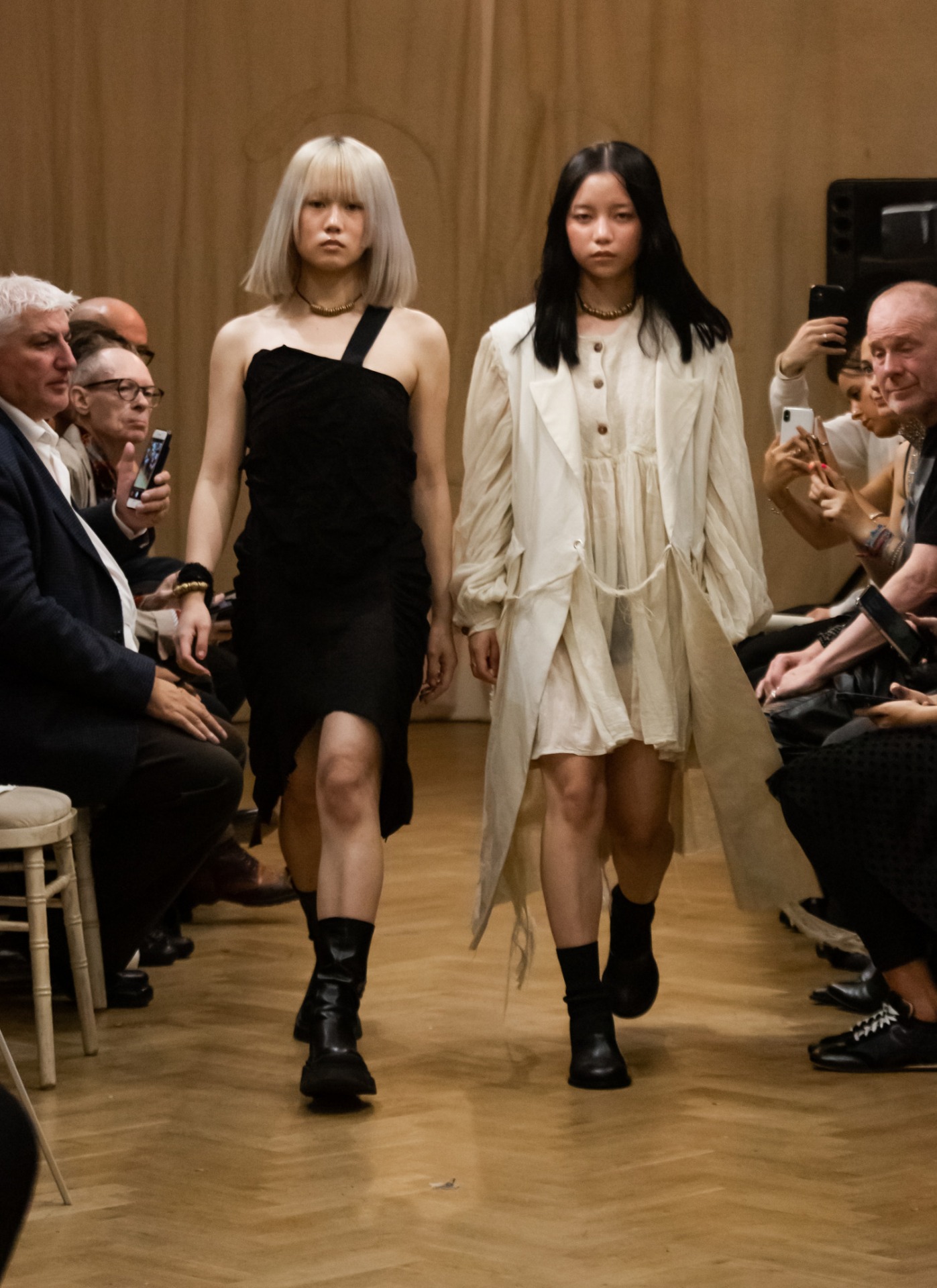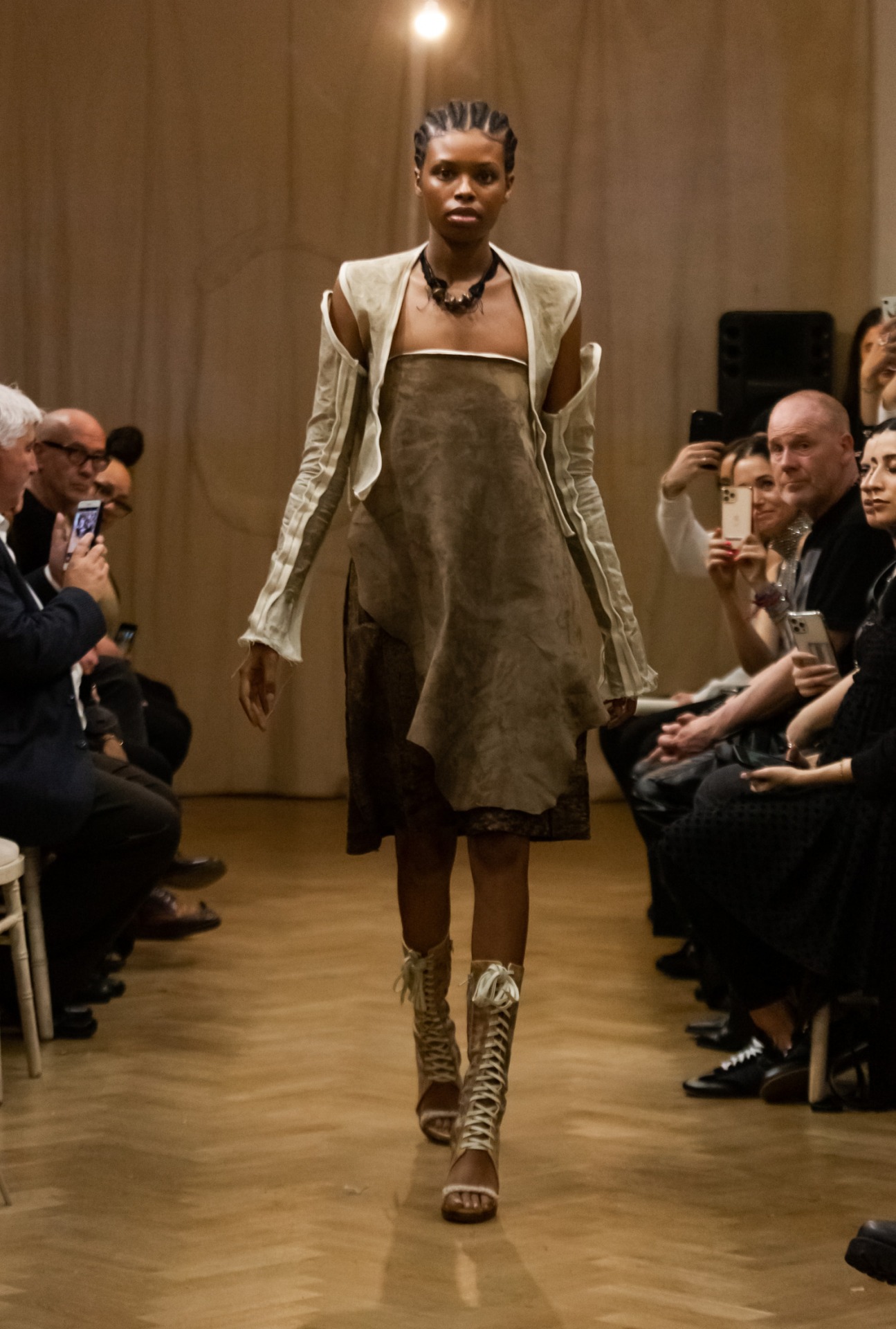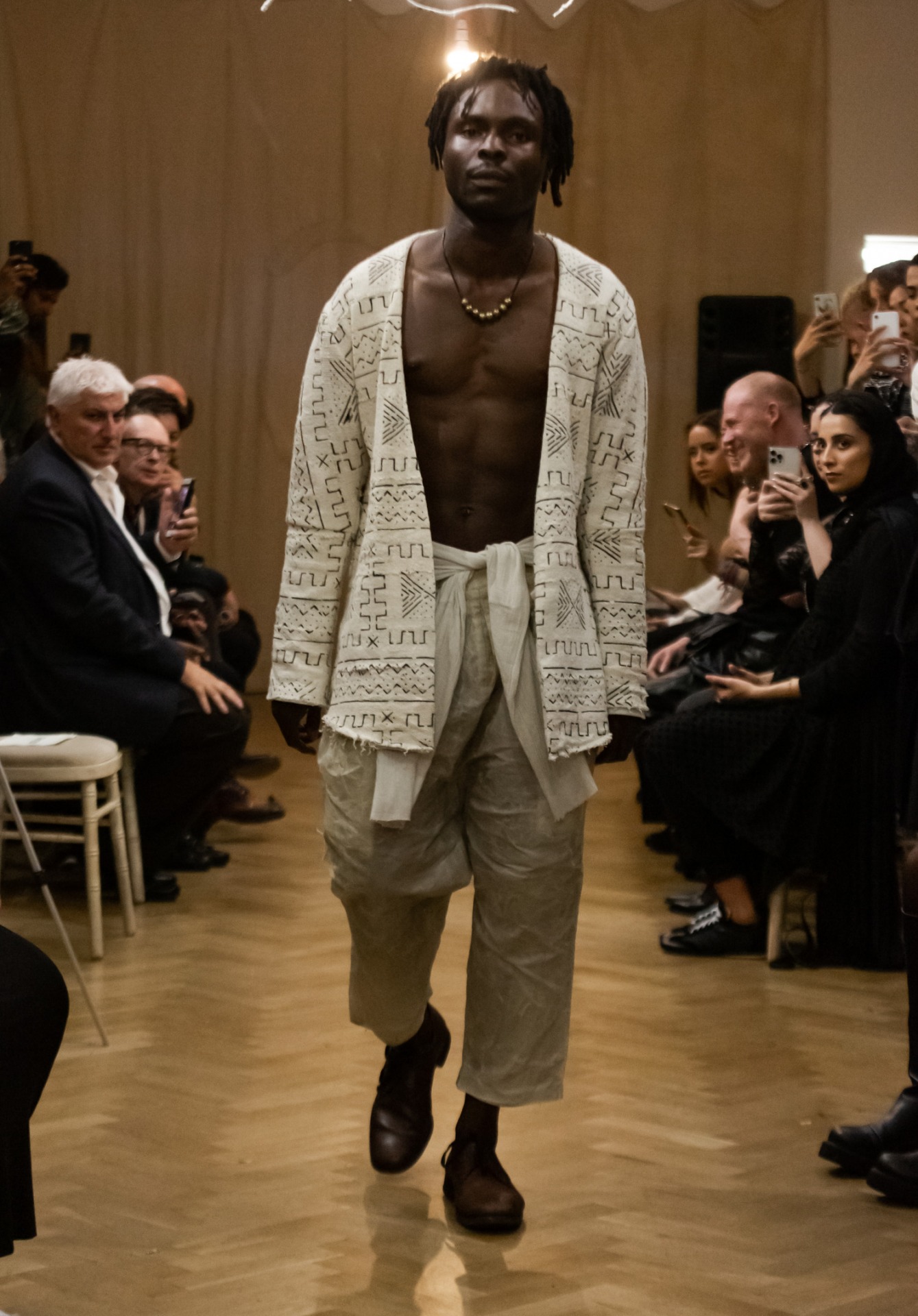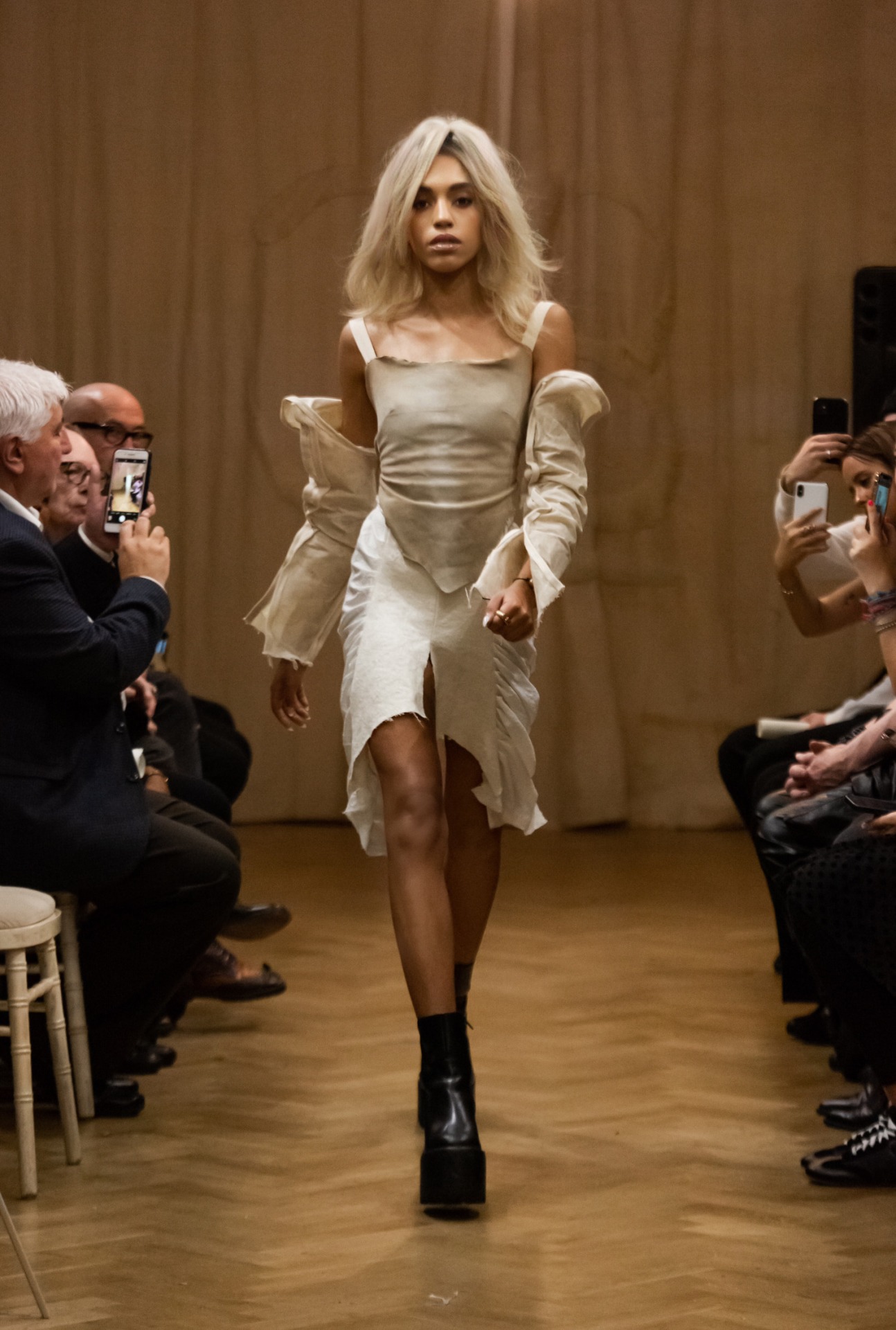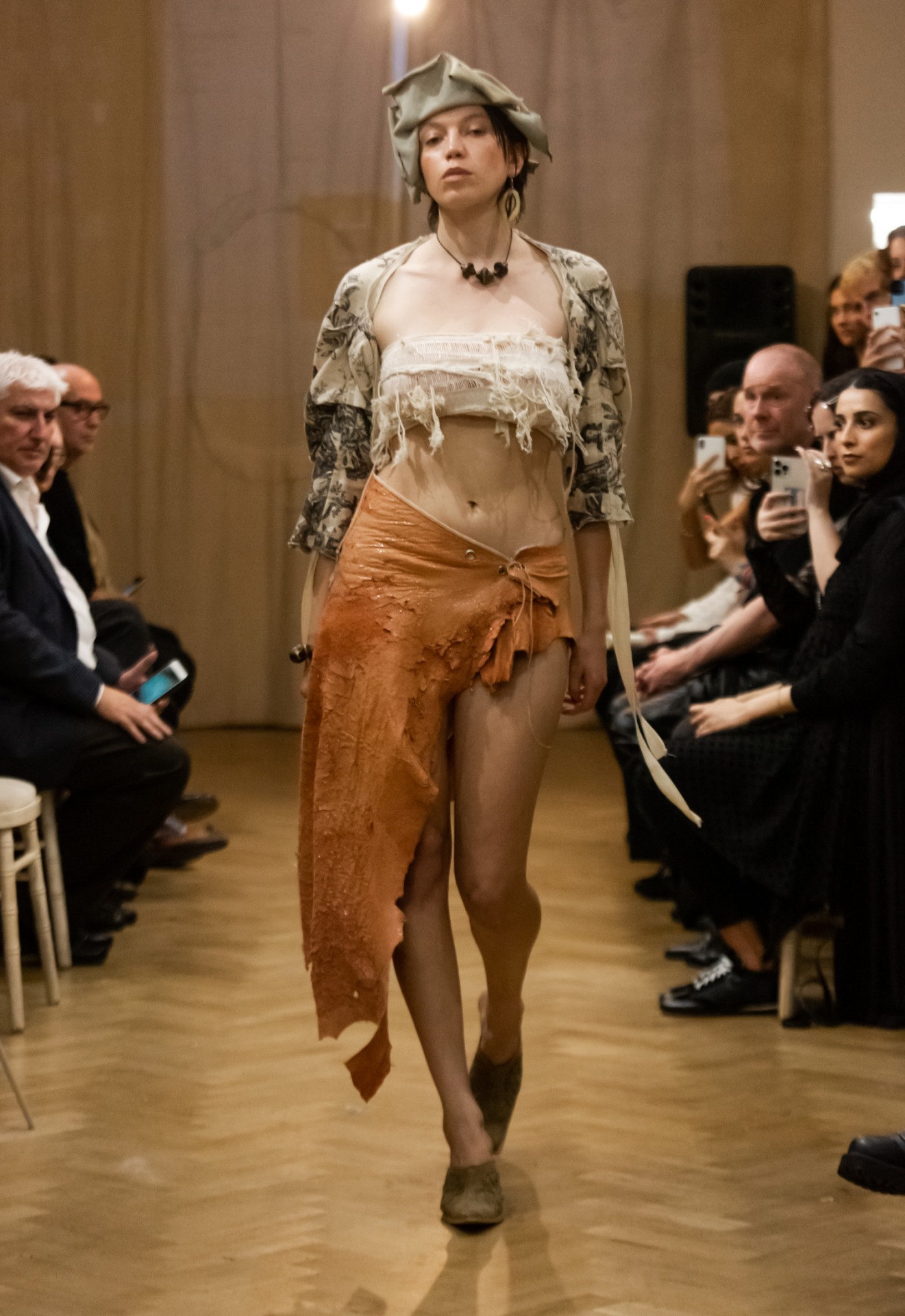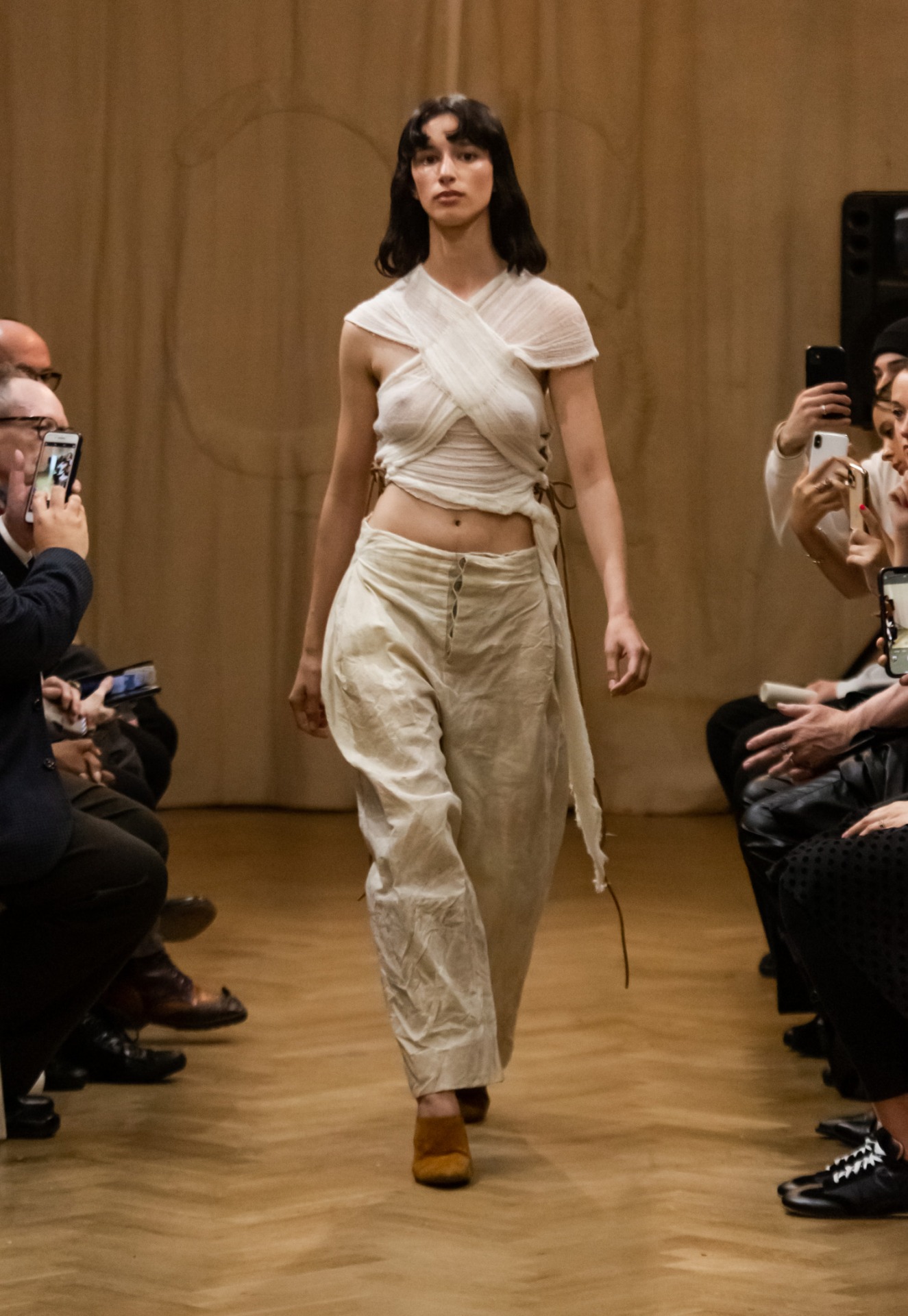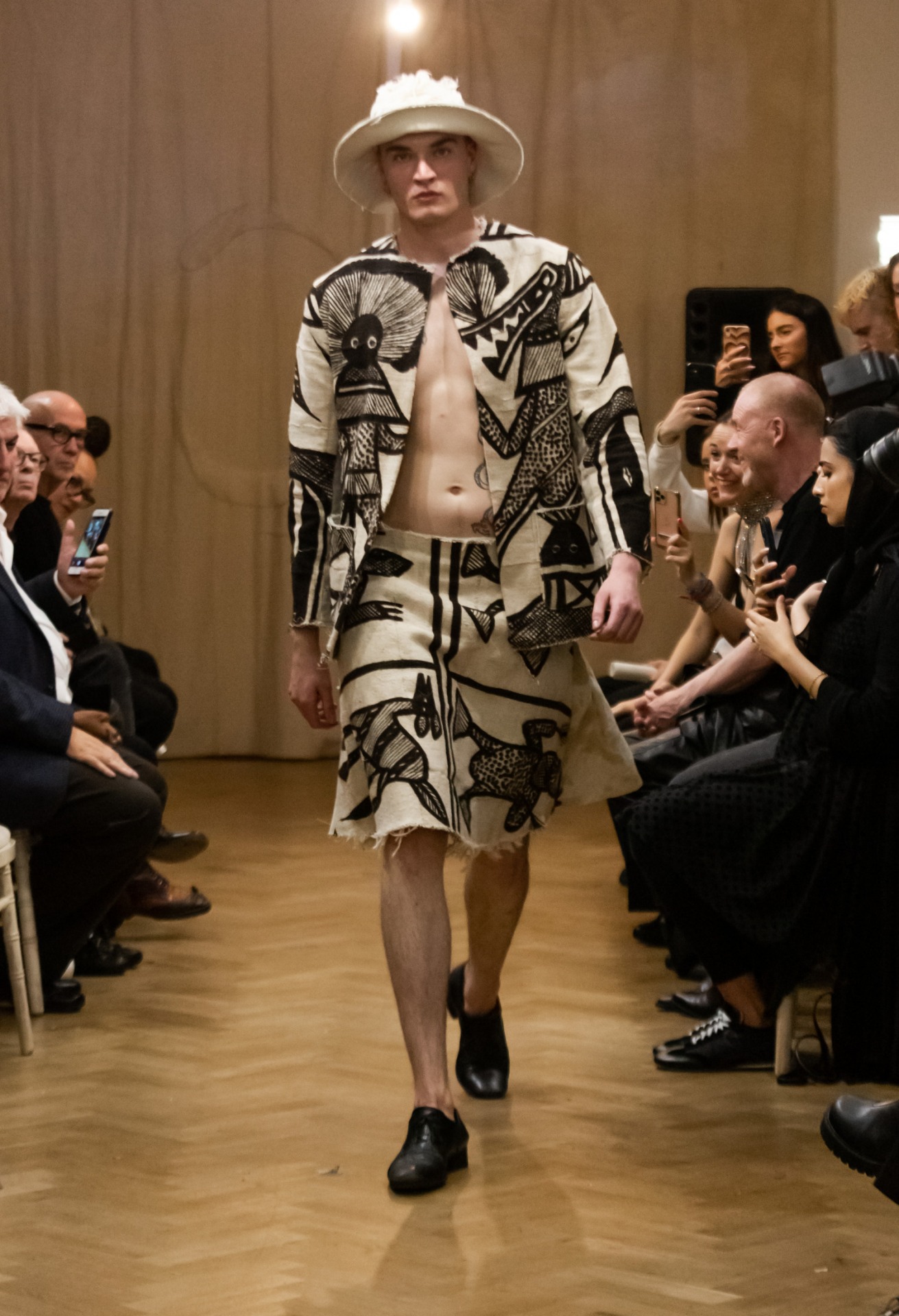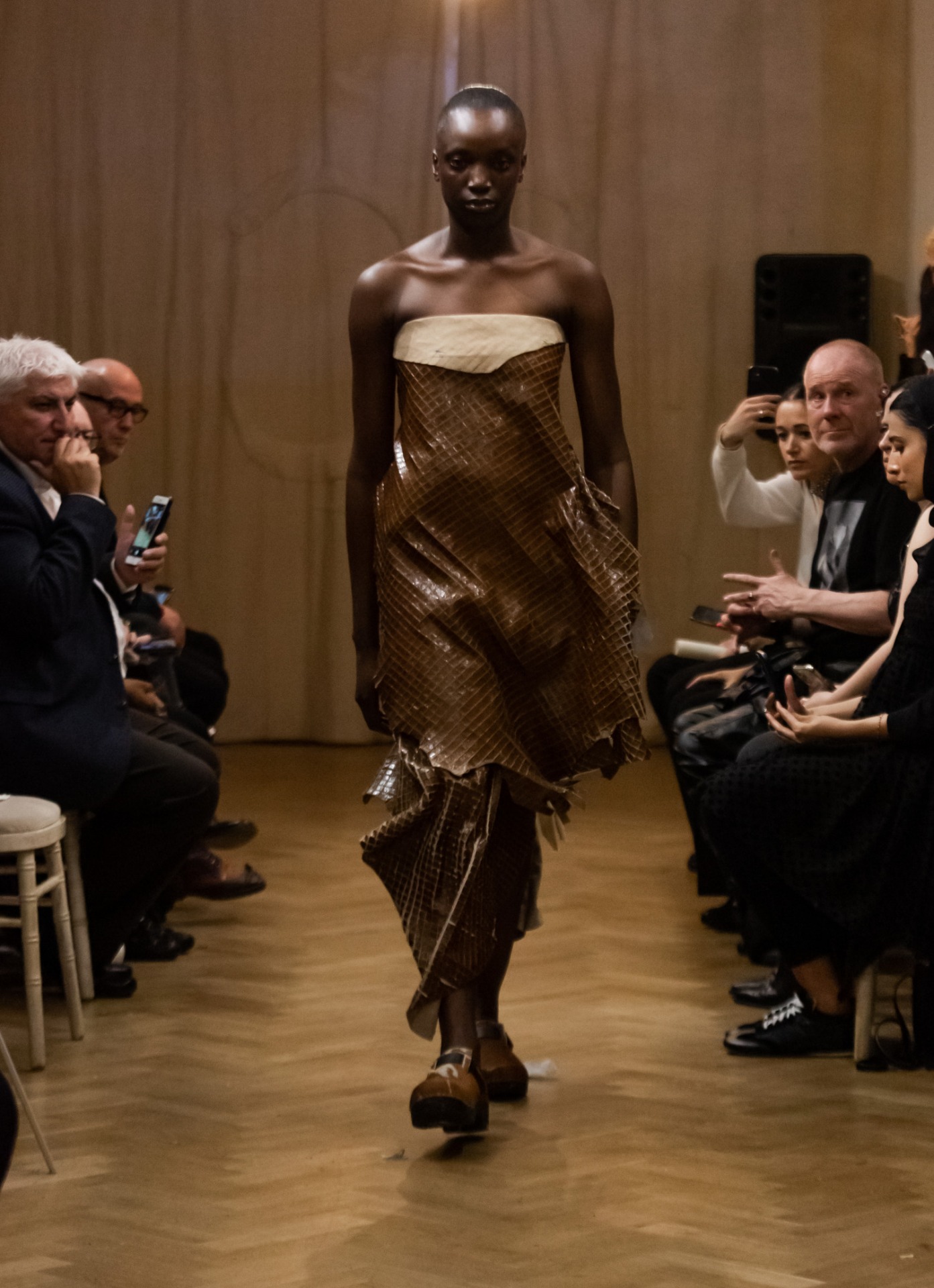Olubiyi Thomas established his eponymous independent label five years ago, debuting his inaugural collection in June 2016.
The designer reflects on and explores his Nigerian origins and Scottish upbringing, these cultural touchstones imbuing the creative process with a desire to vividly re-imagine the linkages between British Post-Colonialism and African cultural history. A desire to tell stories that examine multiculturalism and hidden histories. Influences which coalesce with a number of others drawn from the arts and the designer’s fascination with society through the ages. Influences as diverse as the paintings of Hieronymus Bosch, the works of Yinka Shonibare, Nollywood, to Victorian England, cottage industries and historical civilisations.
Olubiyi takes an artisanal and intentional approach to all that he does, exploring archaic textiles and textures, reinterpreting historical references as the genesis for his designs. It’s an approach that manifests itself in a signature yet constantly evolving style, which bears testament to his background in tailoring. An approach that sees elongated silhouettes that drape and layer exquisitely, with raw edges that complete the deconstructed aesthetic. With each garment handmade in London, it’s an approach that is cemented by a staunchly sustainable ethos which underpins everything that the brand creates.
Noctis was thrilled to be invited to view the SS22 collection entitled “Let it Rain” at the brand’s in-house fashion show held in his Covent Garden atelier during London Fashion Week. Staged independently and without support from any of fashion’s governing bodies, the show was a tour-de-force immersive experience incorporating the runway with film and live music. In many ways, a celebration of the brand’s 5th anniversary; it also marked a significant point in the designer’s upward trajectory with the new physical space that he shares with like-minded people envisioned as a place where communal creativity will flourish.
We spoke to Olubiyi shortly after Fashion Week to ask about the collection, the influences and life lessons that have brought him to this moment in time and his aspirations for the future.
Congratulations on the new atelier in Covent Garden; it’s a fantastic space. What can customers expect from it when they visit?
I guess the whole idea behind the modular boutique was to create some sort of destination. A contrast to the digital landscape and everything being online. And in terms of the stage of my clothes, a lot of it is about texture, the cut and the fit. I have a background in tailoring, so I thought I could incorporate all of those things together. So when you come to the shop, you’ll see some of the old archived designs, the new season, and we also do a lot of made-to order tailoring services, and we have old fabrics there as well. And if people see something they like that doesn’t fit, I can draft it up in some of the fabric I have there already available so just to give people a personal experience when they come so that they don’t just feel like a number.
As people are always asking about sustainability nowadays, it’s a chance for people to see how things are constructed within the store. And at least when people see it being made in-store, they trust it a bit more.
Azura Lovisa, who we also love, is sharing that space with you. Did you envisage the atelier as a kind of incubator where other creatives would be there with you as a place to share ideas and work together?
100% Gaika and I have collaborated on a lot of projects recently, SS22 “Let It Rain; he did the show music in collaboration with H4S (Henry Bennett), loads; we collaborated on the AW21 Future Highlander film, he did the score, and I have also been a fan of his music for a long time. I think sonically, his aesthetic stuff and mine go together. with the visuals that are mine. I didn’t have a strong womenswear presence yet, but as of now, that has really taken shape. And it’s great to have Azura’s stuff there and to work together in terms of the aesthetic of the store because she tells a different story to mine, but they are of the same world. Also, in the world of fashion, people want to create the demigods, where one individual is this creative genius when actually that’s not really how it works; people work as a team or in a community for creative inspiration. When you are surrounded by other creatives, it’s so much easier to get inspired; it just makes sense.
You mentioned teams there, and I think you interned with James Long and also with McQueen, and you were head of menswear with De Rien, the London based brand. How did those experiences prepare you for opening your own studio, and what life lessons did they give you that you have taken with you to Endell street.
When I was at McQueen, I definitely learned a lot; it wasn’t as hands-on as you would imagine, but I got a lot of responsibility in terms of designing and research. I think the main thing I learned when I was there, I mean it’s not a brand; it’s a big fashion house, they are connected to the Gucci group. It’s really interesting to see how someone like that organises themself and their processes and how they work. They had a specific textiles team, a separate print team, a menswear team; everything was in specific sections. I thought that was quite interesting, and I got taken to Milan as well to see how they executed the show and the presentation. All those things you pick up without even realising. I have always been interested in beautiful fabrics and textiles. When I was there, I got to see textiles and fabrics that I had never seen before, and we were creating for the next season, so that was really nice. And I also saw the big commercial side of things when I graduated, and I got the job with Derrien; there was a really nice synergy between myself and Cosmo, the menswear designer there. And we were roughly around the same age as well, so that was really cool. It was like designing and having a brand with somebody else. Richard was there as well, but I’d say that he was more on the research side of things. They were always bringing in this amazing vintage stuff. Their collection of vintage stuff was insane, and it’s really funny because that’s how I actually got the job because I was always down at the markets, looking for fabric there and buying vintage clothes for research. I bumped into Richard on their stall, and I said, oh, you’ve got a brand, and one thing lead to another, and quite quickly, they took me under their wing.
To be honest, they taught me a lot about the process of how to execute a fashion brand and make it sustainable at the same time. Don’t get me wrong, there were a lot of mistakes [Laughs], but they were the crucial learning curves where I realised don’t do that, don’t do this. So, I took that away with me. When I was there, I was going from research to design development to pattern cutting to finishing off the actual end products with other pattern cutters, and then eventually, they opened a shop in Waterloo. Downstairs they had an atelier, upstairs they had a shop. I was in charge of most of that apart from Cosmo and Richard; it was their business, but I was running a lot of it on my own when they weren’t there, so some days I would be down in the basement, and the door would go, and I would have to run upstairs and serve the customers. Then I was back pattern cutting downstairs. I also introduced them to a lot of buyers and retailers in Paris as well; they had to make sales, so I felt like after that I was quite equipped. I was there for two years, so then I was ready to start my own thing because I had learned a lot from them.
You have a real artisanal approach to what you do, and you mentioned fabrics and fibres, which meld with historical references. What inspirations and mediums did you draw on to produce what is a signature but constantly evolving style?
I would say there’s a lot. In terms of historically and I guess connecting that to the present, personal identity is one, but then in a broader sense for me, it’s the idea of multiculturalism. When I was writing my dissertation at university, I was reading a lot of Edward Said and Homi Bhabhi, and he had this theory of the third space, so what he was talking about was your identity and your identity or your cultural narrative being discussed by all the different cultures. They would all sit around a table and have a meeting and all the different attributes that they would give to your personality. I thought that was really interesting, and there was a lot of discourse around post-colonialism. For me, it was more of a positive sense of what is your makeup, deconstructing that and all of your different cultural attributes in terms of clothing, dress, food, music and the textiles and those kinds of industries within those cultures. For me, that’s my kind of solid go-to [laughs]. It’s a lot to make sense internally, so it helped me make sense externally in terms of a patchwork.
Obviously, it made sense to many people because you were a finalist in the BFC British Fashion Fund award. How did it feel to be recognised by those bodies and shortlisted along with people like Supriya Lele and Halpern. How did it feel to have your work recognised with people in that kind of sphere?
I was quite shocked; I was quite surprised, I have to say because I think since there birth of my brand, I have been communicating with these fashion governing bodies to see if they would sponsor me or help me out and mentor me in any sort of way and I got a little bit of backlash to be fair. And I think that why I am surprised is because when I was in my interviews, my feedback was that they couldn’t see the growth of my brand because they didn’t understand how the process of doing small runs and small orders, how I could expand that through being sustainable. We are talking about 2017-18. There was talk about these things, but I don’t think the fashion industry was really taking it that seriously. So, I came quite early with those sorts of ideas, and they didn’t really understand, but I was obviously happy in any case. I was completely thrilled because, obviously, the brand has been going for five years. To finally get that recognition after five years, that was almost like, is this real! I thought, how has this happened? But I was happy.
You made a pre collection fashion film Dance number 2 in conjunction with Sivan Rubinstein, the artist in residence at Kings College. We wondered how that collaboration came about?
This was pre-pandemic, and we were all together in a building in Bermondsey called the Biscuit Factory. So, we all met there, and Sivan had a dance studio in there, and I was next door. It was a huge building, there were over 200 hundred artists. It was an amazing hub of creativity. The only thing left to happen was collaboration. So, a lot of the time, she was putting on performances, and she would pop in and say, hey, I’m doing this thing, and I was always happy to help her out and style the dancers and vice versa. During the pandemic, she reached out to me and said she had this arts council funding to do this project. Before the pandemic hit, I had two weeks left of prep for my Future Highlander show, and obviously, suddenly everything got shut down, and I had no contact with lots of people, and Sivan had agreed to offer up three of her people, and we had this whole dance organised. So we got chatting about it, and later she got the funding, and she had this idea about generation Z it was about sustainability and climate change, and she wanted it to be edgy, and I got the opportunity had to visit go to The Place (the UK’s premier centre for contemporary dance) a dance college. They were the ones that were sponsored in the whole project, they were the ones that gave her the space to perform. During the rehearsals, while we did the entire thing, I was recording the performers, and so half of what you see in the film are recordings of the rehearsals. We patched it together along with other footage to make the film.
The film spoke to the climate emergency; it spoke to nature’s roots. With regard to your own Scottish Nigerian roots, we wondered how they have nurtured your growth and influenced you as a designer?
It’s been really interesting because of a backlog of ideas in terms of historically and also as a sort of message for people; it’s a positive one. A clash of two very polarised identities in terms of where they are on the planet and also in terms of the cultures themselves. They are quite far apart to have that as a foundation to work with makes it very colourful and playful. There’s a lot to draw from. Some people might not have all that richness, and also, I would say the one thing about the Scottish and Nigerian people they do not get any more upfront. There’s no messing around. These days and also in the fashion industry, to have that sort of backbone it’s going to take you quite far because you need a thick skin. It’s not for the faint-hearted. [laughs]
We loved the show. Thanks for inviting us; it was a tremendous evening. Obviously, we have talked to you about your film and the digital side of things. Do you prefer the immediacy of having a show, or do you prefer the cinematic scope that a film brings? If you have a preference, what would it be?
All I can give you is the pros and cons; in terms of cinema, I feel it allows you to create a world that tends to most of your senses. The space, the movement, the textures, sounds, the characters, the backdrops; it can be all about the message you are trying to get across, and it can be very precise, and you can cut through all the crap. It can be three or four mins and punchy. It sounds a bit woke but in terms of energy, when you have a room filled with people, and you have that excitement and energy; I think that is something that is almost impossible to replicate because it’s real life and it’s more like you really had to be there to feel that. For the message I am trying to get across, I think it’s really crucial because it’s about people coming together, and we realise that we need it. When you are stuck in a room with your laptop for a year, and you aren’t allowed to see your family or your friends and go to the pub or see a film and concert, you start to realise what we are as human beings.
You opened the atelier and created this collection during the pandemic, and we just wondered if that caused any difficulties in terms of sourcing or supply chains? If it did, how did you circumvent it?
It’s funny because there were so many restrictions that I think in general, it was very tricky for a lot of people, but I think I had put those restrictions on my process anyway quite early on. I had gone to premier vision, and I had gone out there to look at fabrics, and I just thought there’s no point going to a big company to produce a fabric. I wanted to use fabrics that already existed and local manufacturers and then along with that, it kind of pushed me to find weavers. I needed to speak to local people, and that’s when I found other like-minded people. We shot Future Highlander during the pandemic, and that was a pretty risky move; it was quite heavy. Legally we were allowed to film in Epping Forest. We did everything properly and got licences. It just took one passer-by with their dog to make a complaint about us, saying there were people in the park, and we got investigated.
It’s been a hugely productive year for you. What does the rest of 2021 hold for you, and what are your longer-term aspirations and plans for 2022?
I have a couple more collaborations on costumes. I am going to be working on a collection of purely outerwear for Christmas and January time. I might even skip a season next year and focus on production, focus on the shop. I also have another film for SS22 that will be released for Let it Rain. That concept is similar to the fashion show. I think, to be honest, I’m on the brink of burnout. I think the next two weeks I am going to take a break and go and see family and friends. And maybe try to restructure the brand so that it’s a bit more sustainable.
Every piece of Olubiyi’s collection holds within them a story of heritage, from the fabrics to the inspiration. That story of heritage and identity resonates with a new generation, who values excellent craftsmanship, authenticity, transparency, and a desire to look after the planet. Olubiyi’s vast experience in the industry has served him well to create a stunning brand and atelier that also serves as a place to bring together a community that inspires one another with their own unique values and reference points but also with a shared vision. And that can only lead to even greater things.
Thanks to Olubiyi for taking the time to talk to us and to Holly for making it happen.
You can connect with the brand physically at their atelier, 37 Endell Street, London, WC2H 9EE, on their website www.olubiyithomas.com
Follow Olubiyi Thomas on Instagram
Words: Brian James and Leigh Maynard


